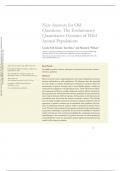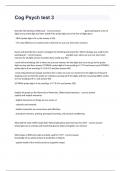New Answers for Old
Questions: The Evolutionary
Quantitative Genetics of Wild
Annu. Rev. Ecol. Evol. Syst. 2008.39:525-548. Downloaded from www.annualreviews.org
Animal Populations
Loeske E.B. Kruuk,1 Jon Slate,2 and Alastair J. Wilson1
by 84.226.240.96 on 11/05/10. For personal use only.
1
Institute of Evolutionary Biology, School of Biological Sciences, University of Edinburgh,
Edinburgh EH9 3JT, UK; email: loeske.kruuk@ed.ac.uk, alastair.wilson@ed.ac.uk
2
Department of Animal & Plant Sciences, University of Sheffield, Sheffield S10 2TN, UK;
email: j.slate@sheffield.ac.uk
Annu. Rev. Ecol. Evol. Syst. 2008. 39:525–48 Key Words
First published online as a Review in Advance on heritability, genetic variance, genotype-environment interactions, natural
September 10, 2008
selection, genomics
The Annual Review of Ecology, Evolution, and
Systematics is online at ecolsys.annualreviews.org Abstract
This article’s doi: Recent years have seen a rapid expansion in the scope of quantitative genetic
10.1146/annurev.ecolsys.39.110707.173542
analyses undertaken in wild populations. We illustrate here the potential
Copyright � c 2008 by Annual Reviews. for such studies to address fundamental evolutionary questions about the
All rights reserved
maintenance of genetic diversity and to reveal hidden genetic conflicts or
1543-592X/08/1201-0525$20.00 constraints not apparent at the phenotypic level. Trade-offs between differ-
ent components of fitness, sexually-antagonistic genetic effects, maternal ef-
fects, genotype-by-environment interactions, genotype-by-age interactions,
and variation between different regions of the genome in localized genetic
correlations may all prevent the erosion of genetic variance. We consider
ways in which complex interactions between ecological conditions and the
expression of genetic variation can be elucidated, and emphasize the ben-
efits of conducting selection analyses within a quantitative genetic frame-
work. We also review potential developments associated with rapid advances
in genomic technology, in particular the increased availability of extensive
marker information. Our conclusions highlight the complexity of processes
contributing to the maintenance of genetic diversity in wild populations,
and underline the value of a quantitative genetic approach in parameterizing
models of life-history evolution.
525
, 1. INTRODUCTION
Quantitative genetics has an ugly name, but it is a subject that it is integral to an understanding of
most evolutionary processes. Evolutionary change within a population requires that any changes in
the distribution of phenotypes within a generation—typically due to natural selection—be passed
on to subsequent generations via a genetic basis. Quantitative genetics is simply the study of this
genetic basis where the trait of interest is quantitative and likely to be influenced by multiple
genes and environmental factors, which is probably the great majority of traits in which we might
be interested. It may therefore appear heavily descriptive, centered on questions such as, “How
much genetic variance?” or “Which genes?”. However the answers to these questions underpin a
range of important issues in evolutionary biology. In particular, Darwinian natural selection has
great intuitive appeal, but presents a paradox: If only the fittest survive, why do less fit genotypes
persist? What maintains genetic variance in the face of continuing erosion by natural selection?
Annu. Rev. Ecol. Evol. Syst. 2008.39:525-548. Downloaded from www.annualreviews.org
Is there heritable genetic variance for fitness? What role do trade-offs play in the evolution of
life histories? Such questions have widespread implications for all aspects of evolutionary biology
(and many aspects of ecology), and addressing them requires knowledge of the genetic architecture
underlying phenotypic diversity (Barton & Turelli 1989).
In this review, we focus on insights drawn from quantitative genetic studies of wild animal
by 84.226.240.96 on 11/05/10. For personal use only.
populations inhabiting natural environments, an area in which there has been much recent activ-
ity (Roff 2007). The drive to explore genetic architecture and microevolution in wild populations
has a dual motivation. First, much of evolutionary ecology rests on a theoretical foundation pro-
vided by classical quantitative genetics, although this is not always realized and critical underlying
assumptions frequently remain untested (see discussion in Owens 2006). Phenotypic patterns of
covariance are unlikely to provide an accurate representation of underlying genetic patterns, and
it is becoming increasingly clear that researchers interested in the evolution of life histories need
to delve deeper than consideration of phenotypic associations. Second, although it is undoubtedly
easier to explore genetic effects in artificial (domestic or laboratory) populations experiencing con-
trolled conditions, increasing evidence for the impact of environmental conditions on evolutionary
trajectories suggests that extrapolation from such studies to a more general evolutionary context
may be limited. In this review, to make the case for wild quantitative genetics, we outline recent
results supporting these assertions. Returning to the question of what maintains genetic diversity,
we show how studies of the quantitative genetics of wild populations have revealed trade-offs that
are either not apparent or not estimable at the phenotypic level, and explore factors that contribute
to the maintenance of quantitative genetic variance in natural environments.
At a practical level, the increasing interest in the study of quantitative genetics in wild, rather
than agricultural or laboratory, study populations has been greatly facilitated by recent method-
ological advances. On the molecular genetic front, faster and cheaper technology has rapidly
accelerated the collection of genetic data with which to determine parentage and hence build
pedigrees (Pemberton 2008), or to map individual loci (Slate 2005). On the statistical front, the
increased application of more complex mixed model pedigree analyses, specifically the “animal
model,” has allowed detailed interactions of genetic and environmental effects to be modelled
(Kruuk 2004; Nussey et al. 2007). Many long-term studies of wild populations for which pedigree
information are available are now exploring the numerous different avenues provided by such data.
However, quantitative genetics studies do not require long-term pedigree information—for exam-
ple, some of the most elegant studies of evolutionary genetics have come from single generation
experimental designs (see review in Merilä & Sheldon 2001).
We begin this review with a brief introduction to the relevant methodology (Section 2). In
Sections 3–5, we consider evidence for genetically-based trade-offs either between different
526 Kruuk · ·
Slate Wilson
, components of fitness, or via sexually-antagonistic genetic effects, maternal effects, genotype-
environment or genotype-age interactions. In Section 6 we consider the use of a quantitative
genetic approach to estimate selection, and in Section 7 we explore potential insights from ge-
nomic data. Finally, we discuss the application of the breeder’s equation to natural populations
(Section 8).
2. METHODOLOGY
A quantitative genetic analysis requires that individuals in a population be measured for one or
more phenotypic traits of interest, and that information on the relatedness among those individ-
uals also be available (Falconer & Mackay 1996, Lynch & Walsh 1998). Relatedness, or pedigree,
information may be constructed from behavioral observations or from genetic marker data (Pem-
berton 2008). Phenotype and pedigree data can then be combined in a statistical model to estimate
Annu. Rev. Ecol. Evol. Syst. 2008.39:525-548. Downloaded from www.annualreviews.org
key quantitative genetic parameters such as the magnitude of additive genetic variance (VA ) un-
derlying a trait, its heritability (h2 , the ratio of VA to total phenotypic variance VP ), and genetic
correlations or covariances with other traits. The simplest approaches consider the covariance
in the phenotype of parents and offspring (parent-offspring regression), or of groups of siblings
(full or half-sib analyses of variance: for details see Falconer & Mackay 1996, chapter 10); these
by 84.226.240.96 on 11/05/10. For personal use only.
approaches have been adopted by numerous studies to estimate heritability in natural populations
(starting with Boag & Grant 1978). Where information on several different types of relative is
available, a more powerful approach is to consider covariance between multiple sets of relatives
simultaneously, using a form of linear mixed model known as an animal model that includes as a
random effect a polygenic additive genetic effect with variance-covariance structure determined
by the additive genetic variance and the pedigree (Henderson 1976; Lynch & Walsh 1998, chap-
ters 26 and 27). The animal model approach also allows other components of the phenotypic
variance such as common environment or maternal effects to be modelled explicitly, and has be-
come increasingly popular in studies of wild populations in the last decade (Kruuk 2004, Kruuk
& Hadfield 2007). Parameter estimation is then typically completed via restricted maximum like-
lihood; to date, Bayesian approaches have been relatively underexploited in evolutionary biology,
but this is changing (O’Hara et al. 2008).
At the individual level, the animal model can also estimate breeding values, or an individual’s
additive genetic merit, for a given trait (Falconer & Mackay 1996, p. 114). Estimated breeding
values (EBVs) can be used, first, to test for temporal trends in underlying genotypes (genetic trends)
that may differ from those at the level of the phenotype, or to compare associations between EBVs
and fitness as an indication of the genetic basis to selection (Kruuk 2004, Postma 2006). These
possibilities are enticing but, as we discuss below, recent work has emphasized the need for caution
in their interpretation.
Alternative approaches are available to derive quantitative genetic estimates directly from com-
binations of phenotypic and genetic marker data, with no (or only limited) explicit pedigree infor-
mation (Mousseau et al. 1998, Ritland 2000, Thomas 2005). However, despite the great appeal of
being able to side-step the need for pedigree information, the uptake of these approaches has been
limited, probably owing to reservations about their accuracy (Coltman 2005, Garant & Kruuk
2005). Wild quantitative genetic analyses therefore remain dominated by populations for which
some form of pedigree data is available, even if it is acknowledged that there may be some error
in pedigree links (Pemberton 2008). These studies typically involve either long-term pedigrees
or the use of an experimental approach such as cross-fostering to separate out environmental
sources of similarity between relatives from those due to genetic effects (or, ideally, both; Kruuk
& Hadfield 2007). The development of a Bayesian approach to incorporate behavioral and spatial
www.annualreviews.org • Quantitative Genetics of Wild Populations 527





